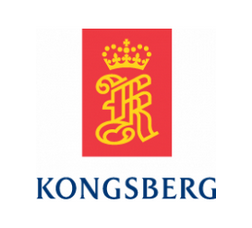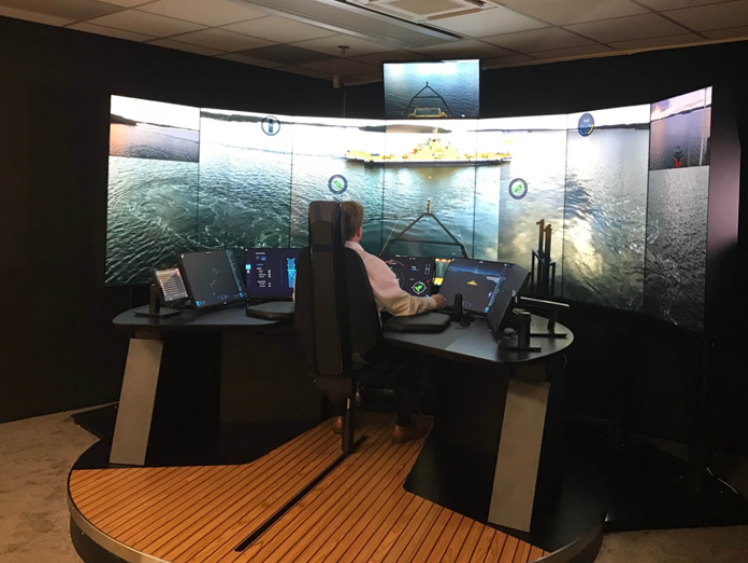- COMPANY

Kongsberg (https://www.kongsberg.com/ )
- SEMINAR’s focus
Remote Operations Centre Solutions
- DESCRIPTION:
KONGSBERG is a world leading technology company within Maritime, Defence and Aerospace and Digital domains. Our product development unit in Turku develops Remote Operations Centre (ROC) Solutions for the Maritime Industry that are used in operations with vessels and other floating structures.
The two main drivers for introducing a remote operation is increased efficiency and safety. Efficiency increases for instance when multiple vessels can be operated and the total number of crew involved can be reduced. Safety increases when humans can be removed from hazardous working environments and state of the art onboard sensors provides improved decision support to a shorebased operator.

A ROC with operator stations and fleet management.
There are three main requirements to make a remote operation work; onboard sensoring, connectivity and a Remote Operations Centre. Onboard the vessel there needs to be sufficient sensor suite in order to be able to provide the needed data and information to a remote operator. Sensors can be standard navigational sensors like position and RADAR sensors. Sensors can also be different types of cameras and laser based sensors. The sensors used are depending on the type of operation. Key in the end is to enable the needed internal and external situational awareness to the remote operator. Internal means the status on the vessel, for example machinery systems and alarms. External situational awareness means the information of what is happening outside the vessel, for example information about other vessel traffic and weather.
The communication between vessel and shore is done with a multicarrier connectivity system. Data transfer is secured with a Cyber Security system. Carriers used in the connectivity system can for example be 3/4G mobile, satellite, maritime broadband radio or others.
In a ROC operators can perform monitoring, support, assistance, control and management tasks required in the operation. An operator in the ROC can monitor unmanned autonomous vessels or directly control onboard systems. The vessel can have full manning onboard or be operating with a reduced manning. In case there is manning onboard the operator can support or assist the onboard crew. In support the operator performs monitoring of one or several vessel systems and provides support to the onboard crew as an expert in the loop. In assist the operator handles and controls one or more onboard systems, so that one part of the total mission is controlled from the vessel and another part from the ROC. The operators in a ROC work on operator stations. The operator stations are equipped to meet the specific needs in an operation, and thus look different in a pure monitoring operation compared to a direct control operation.

A remote operator station equipped to enable monitoring and control operations.
- CHALLENGES:
Remote Operation Centers are possible due to the development of technology. For this seminar session we ask the participants to be visionaries and find solutions which focus on: how digital technology will shape the operation and navigation experience for remote vessel operations? To answer this question we encourage the participants to explore diverse technologies and topics to gain inspiration and to visualize a novel future.
Technology:
What advanced sensors can be used onboard the vessels to create the needed internal and external situational awareness?
- When a vessel is being remotely controlled the eyes, ears and the feel for the vessel is no longer onboard. Sensing the vessel behaviour remotely is essential.
How can a remote operation benefit from AI technology and Machine Learning?
- Can the intelligent behaviour of a human be imitated.
- Areas to explore could be visual perception, speech recognition, decision making and translation between languages.
How can AR/VR/XR technologies be used in a remote operation?
- AR/VR/XR use cases
What carrier and link management technologies can be used in a multicarrier connectivity system?
- There is a wide range of communication carriers like cellular 4G, satellite and more. They all have their pros and cons when it comes to capacity, range and cost.
What new and unexplored technologies are out there that could be beneficial in a remote operation of vessels?
- Be brave and explore what is out there, perhaps in another industry, something that no-one ever thought about to be used in this domain.
User Experience:
How can we make the experience for the user with the product to be enjoyable?
5. DAY and TIME
September 18 from 12 to 16hrs
6. SEMINAR LOCATION
Agora building 1st floor, room 110 A+B
Following the current situation of COVID-19, the Department of Future Technology authorizes to impart this session face-to-face pursuant to the department health guidelines:
a) The maximum number of participants to be present in the same room is 20 persons.
Therefore, we have a limited number of seats available. These places will be granted according to the registration form of this session on the first-come, first-served basis.
b) The session is held in a classroom where all the participants can keep a safe distance between them.
For this reason, the next session is allocated in the first floor of Agora building room 110 A+B.
c) We encourage the use of masks and washing your hands
d) A record of the participants will be kept after the session, in case it is needed to inform of any possible exposure to covid-19.
e) If someone from the risk groups wants to participate in the seminar please contact Paula Pietilä (papiet [at] utu.fi)
f) If the COVID-19 situation changes, we will inform to the particpants enrolled to this session of any changes.
7. ENROLLMENT
https://link.webropolsurveys.com/S/B6F0F5F33F038886
8. PRE-ASSIGMENT
Pre assigment description is in this link.
